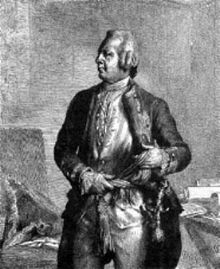Hans Karl von Winterfeldt
| Hans Karl von Winterfeldt | |
|---|---|

engraved image of Winterfeld
|
|
| Born |
4 April 1707 Siedenbrünzow, Mecklenburg-Vorpommern Swedish Pomerania |
| Died | 8 September 1757 (aged 50) Moys, Görlitz |
| Allegiance |
|
| Rank | General of Infantry |
| Battles/wars |
War of the Polish Succession War of the Austrian Succession Seven Years' War |
| Awards |
Pour le Mérite Order of the Black Eagle Name inscribed on Frederick the Great's Equestrian Statue |
Hans Karl von Winterfeldt (4 April 1707 – 8 September 1757), a Prussian general, served in the War of the Polish Succession, the War of Austrian Succession, Frederick the Great's Silesian wars and the Seven Years' War. One of Frederick's trusted confidantes and advisors, he attracted enmity from other courtiers. Frederick entrusted him with considerable autonomy on the general staff, and Winterfeldt developed the first "modern" program of military intelligence gathering. He negotiated the Convention of Westminster and, for his efforts on Frederick's behalf, received the Order of the Black Eagle and the Order Pour le Mérite. He died from wounds received at Battle of Moys. His name is included on the Equestrian statue of Frederick the Great.
Hans Karl von Winterfeldt was born at Vanselow Castle (now in Siedenbrünzow, Mecklenburg-Vorpommern) in Swedish Pomerania. His education was imperfect, and in later life he always regretted his lack of familiarity with the French language.
Winterfeldt entered the cuirassier regiment of his uncle, Major General von Winterfeld, where he served until 1720; he was promoted cornet ( after two years service. He was fortunate enough, by his stature and soldierly bearing, to attract the notice of Frederick William I, who transferred him to the so-called giant regiment of grenadiers as a lieutenant. Before long he became a personal aide-de-camp to the king, and in 1732 he was sent with a party of selected non-commissioned officers to assist in the organization of the Russian army.
...
Wikipedia
